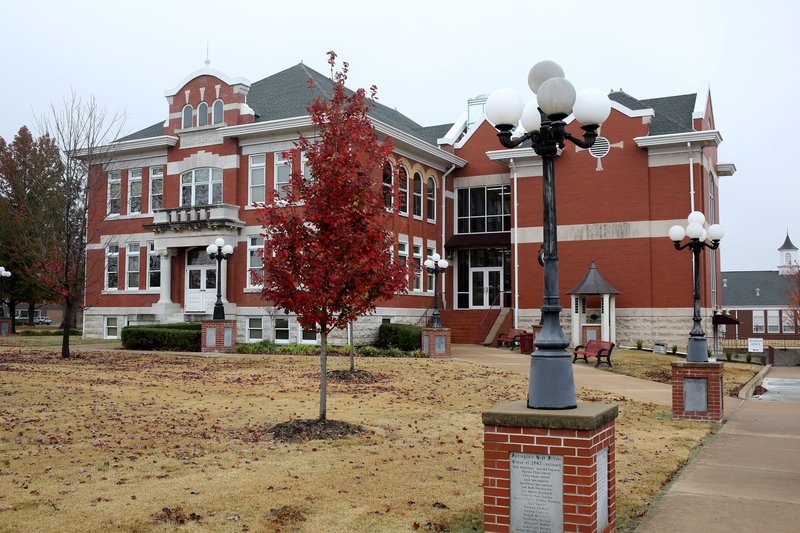SPRINGDALE -- The School District is considering changing its approach to alternative learning programs so it can serve more students.
Melissa Fink, assistant superintendent for curriculum, instruction and innovation, prekindergarten to seventh grade, and Marcia Smith, associate superintendent for curriculum, instruction and innovation, presented the idea to the School Board on Wednesday.
An alternative learning environment program -- commonly referred to by the acronym ALE -- aims to give students the tools and resources to improve how they react to situations, helping them control behaviors and emotions, Fink said in an email.
The district serves 50 students in its alternative learning program for kindergarten through eighth-grade students.
The plan includes bringing the district's alternative learning classrooms for elementary to junior high students together in a wing at Knapp Elementary, Fink told board members. Programs currently are spread out in schools across the district.
Alternative learning students also will participate in regular classrooms at Knapp, with support to control their behavior.
The district plans to hire a principal specifically for the Knapp alternative program, Fink said.
The district also provides an alternative learning program for high school students at the Archer Learning Center in Murphy Park. This program will not be affected, she said.
Staff of Ozark Guidance, an affiliate of Arisa Health, will work more intensely with 10 students. Currently, 20 students receive services in this special class.
Fink said the change will save the district $35,000 to serve more students in the younger-grade programs.
"Sometimes students come to school lacking the ability to regulate their emotions and behaviors for various reasons," Fink said. "Schools provide a lot of support to these students in the general education setting. Behavior specialists are often called in to provide strategies for teachers to try."
Springdale's program is designed to provide "wrap-around services" to students and families, she said.
"Our district helps students and families access mental health services through our local mental health providers," she said. "If students aren't experiencing success after the classroom support has been put into place, then a referral is made for a student to attend an ALE program. ALE gives students more intense support in a smaller classroom setting."
One teacher serves just 10 students.
"Our ALE classrooms are not punitive," Fink said. She noted the classes are located in schools, so students can still participate in regular classrooms with support to control their behavior.
Elvis Perez, a seventh-grader at Kelly Middle School, graduated two years ago from the alternative learning classrooms at Walker Elementary. He said his teachers at Jones Elementary School recommended him for the program.
The program helped him because he's not getting into fights or trouble as he did before the program, he said.
Elvis' favorite thing about the program was the teachers. But he said he didn't like being in classes with students in other grades. He didn't appreciate being with younger kids, he said.
"Our ALE programs are currently located on school campuses so students can easily be integrated into general education classrooms," Fink said. Students are pushed with support into regular education classrooms throughout the day.
Prior to a student returning to his home school, he will transition into a regular classroom at the alternative learning school to ensure he is able to apply the skills he has learned in the alternative learning program.
The proximity also will allow teachers and counselors time to collaborate, receive specific professional development and build family relationships, Fink said.
Randy Hutchinson, a School Board member, likes the plan. He said knew about the alternative learning program for high school students, but not for younger students.
"I didn't realize that those teachers were out there kind of on an island by themselves," he said. "I can't imagine teaching in that type of setting. Most teachers have another teacher within probably 10 yards of them to ask questions of, to bounce ideas off of."
The board, after the alternative learning discussion, learned about administrators' plans to improve professional development for all teachers in the district.
Secondary support
An alternative learning program in the Rogers School District, called Crossroads, offers a different program for sixth- to 12th-grade students.
Matt Cook, principal of Crossroads; Kim Smith, dean of students; and Darla Tomasko, executive director of teaching and learning for alternative education and virtual learning; collaborated Friday to answer via email questions about Crossroads.
The goal of Crossroads is to meet students where they are, promote an environment that focuses on individual student progress and develop a positive working relationship with each student and family through restorative behavior practices and tailored classroom instruction, according to the educators. Crossroads leaders also want to give students the opportunity to develop their own voice so they can positively affect their community.
Crossroads for more than 20 years has served several populations. This includes students in need of credit recovery, students who thrive in a smaller and more structured learning environment, students in need of more social and emotional support, and students who need a change in placement due to behavioral needs, according to the educators.
The program serves 150 students, but classrooms have no more than 15 students. Students and their families go through an interview process to be chosen for Crossroads.
Students' schedules are very individualized, based on their needs, the educators explained. A typical student might have four academic classes per day, along with a period for interventions and a period for Renaissance, a program for promoting community service and social-emotional needs.
The Crossroads campus in downtown Rogers also includes the Reality Check project room where students can earn time to relax with a mentor or participate in hands-on activities such as wood working, sewing or painting.
Crossroads has a full-time counselor, social worker and community mental health partnerships.
Crossroads also offers English as a second language special education and supports. Staff is trained in behavior tools, as well as trauma-informed practices including restorative justice, a disciplinary plan in which a student takes responsibility for his actions.
